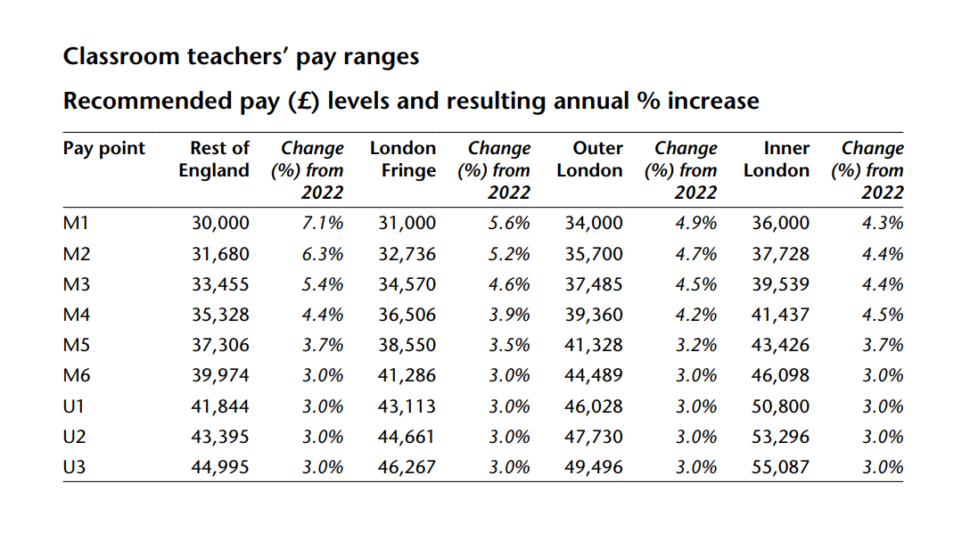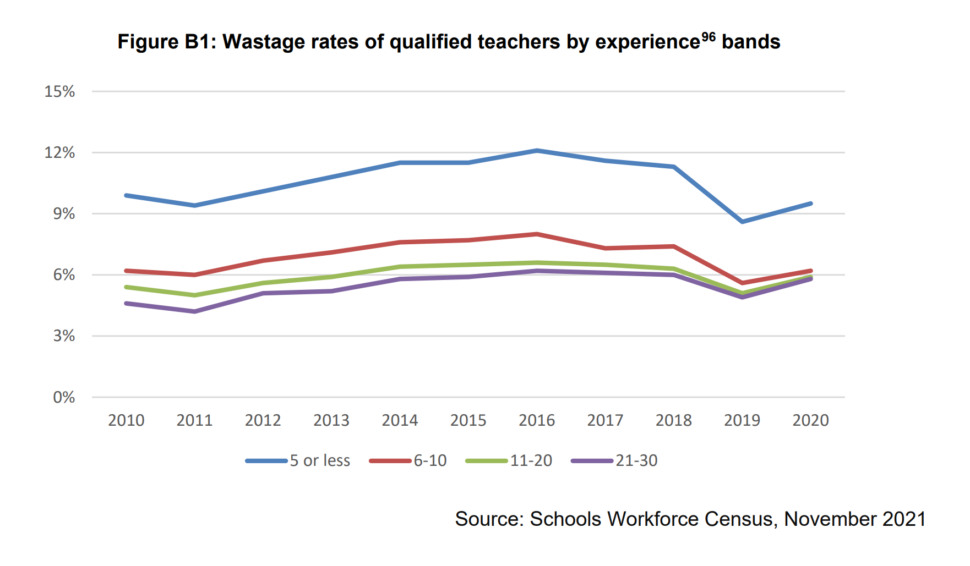[ad_1]
The federal government has actually released the evidence behind its recommendation that spend for the majority of instructors and also leaders climb by 3 percent following year.
Here’s what you require to understand …
1. The recommendations
Although the institution instructors’ testimonial body is complimentary to make its very own suggestions, actually the body is greatly reduced by the “remit” given by the federal government and also its desires laid out forthcoming.
In its newest proof, the DfE has recommended rises worth 3.5 per cent across the board, consisting of:
- A 3 percent surge for those on the top and also management pay arrays (this is most instructors and also leaders)
- A 7.1 percent boost in factor 1 of the major pay array, taking beginning incomes to ₤ 30,000 outdoors London
- ‘ Appropriate conical uplifts’ to staying pay factors generally pay range
The STRB consisted of the complying with picture of the result these increases would certainly carry the pay ranges in its last record …

2. Added financing ‘reinforces’ situation for greater rise
A 3 percent surge was in fact the STRB’s suggestion for 2023 in its last record, yet the DfE picked to just approve its suggestion for 2022 at the time.
Nonetheless, the division stated it currently “identifies the advantages of a 3 percent uplift which the situation for this honor has actually enhanced because of extra institutions moneying given given that the fall declaration”. College financing was raised by ₤ 2 billion.
3. No added financing coming …
DfE stated the suggested 3.5 percent surge on the whole would certainly be “budget friendly” for institutions from their present spending plans offered the current added financing.
Nonetheless, “considerable modification” in coming months “might sustain providing a greater honor for knowledgeable instructors”. As an example, if even more “clearance” appears due to modifications to power price stress.
A greater honor for knowledgeable instructors and also leaders “would certainly naturally have employment and also retention advantages”, DfE included.
4. … and also it can require institutions to make ‘effectiveness’
However, the advantages of a greater honor would certainly require to be “taken into consideration very carefully along with the effect that a greater honor can carry institutions’ spending plans which can call for institutions to make financial savings, with even more considerable compromises”, the DfE stated.
A pay honor over what is budget friendly “can call for decreases in various other locations of institution investing and also the requirement for institutions to make effectiveness”.
A greater pay honor “would certainly additionally run the risk of the battle versus rising cost of living, as it can call for more federal government loaning throughout a time when lasting public funds are important”.
5. Instructor leaving prices climbing again

So-called instructor “wastefulness” prices– the percentage of instructors leaving the career for factors aside from retired life or fatality– had actually normally been dropping given that a top in 2016.
Nonetheless, the most recent information reveals a small uptick in leaving prices in between 2020 and also 2021.
According to the institution labor force demographics, the variety of instructors ending up being “inactive” increased to simply over 32,000 in 2020-21, up from simply over 27,000 in the previous year.
6. Kindness of ₤ 30k beginning income will certainly ‘reduce’
The DfE has actually suggested a 7.1 percent boost in beginning incomes following year, to take them to ₤ 30,000 outside London “without more hold-up”.
This implies the federal government will certainly satisfy its statement of belief promise made in 2019, albeit behind guaranteed.
Nonetheless, in its proof, the division recognized that “as time gaps, the understanding of ₤ 30,000 as a monetarily fulfilling number is most likely to reduce, as various other graduate careers match or start to surpass this number”.
7. No indication of crucial instructor study data
Unions had actually been pushing the federal government to consist of the end result of the federal government’s brand-new “functioning lives of instructors and also leaders” study in its proof to the STRB.
The study was accomplished by IFF Research Study and also the Institute of Education and learning for the very first time last springtime, yet the searchings for are still not out, and also are not consisted of in the proof.
The DfE stated that when the record is released, the STRB “might desire to think about the proof offered there.”
Government wishes to “perform even more thorough evaluation” of the information “in future years”.
8. Dropping student numbers might ‘relieve stress’

In current years, institutions have actually faced boosting student numbers, brought on by an infant boom in 2000s.
Nonetheless, according to DfE quotes, student numbers result from drop by 9.4 percent in between 2022 and also 2030.
The DfE stated this “decrease popular over the coming years can offer to relieve a few of the stress on class instructor numbers”.
Nonetheless, the graduate-age populace is additionally as a result of reduce, supplying a smaller sized swimming pool where to hire instructors.
9. ₤ 2.1 bn ‘clearance’, yet do not blow it all on pay rises
Alongside its proof to the STRB, the DfE has actually released a technological note on forecasted institutions’ expenses.
This approximates that institutions, usually, can manage ₤ 2.1 billion in “brand-new investing” prior to dealing with a “web stress on their spending plans” (though the DfE is eager to mention this will not put on all institutions).
However this does not gauge pay honors for team, or most likely rises to power expenses, so they would certainly require to be satisfied within this quantity.
The DfE additionally stated the clearance number “does not stand for an amount that can be routed completely to instructors’ pay without really considerably effecting on various other locations of institutions’ investing”.
10. Excellent unpredictability over power bills
The DfE has actually asked the STRB to “especially think about” the effect of power expenses, yet recognized these were “presently especially challenging to anticipate with self-confidence at both a nationwide and also institution degree”.
School-level expenses will certainly differ based upon use and also agreements, while “market volatility” implies expenses are “most likely to differ throughout the year”, especially after federal government assistance finishes in March.
The DfE forecasted that every 100 percent boost in power expenses in 2023 would certainly set you back the market around ₤ 600 million, and also stakeholders have actually mentioned rises of approximately 300 percent.
11. Maintain ‘parity’ with personal sector
The federal government has actually stated public market incomes development ought to “keep wide parity with the economic sector and also remain to be budget friendly”.
The Workplace for Budget plan Duty has actually anticipated ordinary incomes development will certainly be up to 3.5 percent in the following fiscal year.
” A 3.5 percent total honor thus keeps competition within the broader work market, sustaining employment and also retention,” DfE declared. “This is much more significant offered the context of the projection economic crisis.”
[ad_2]
Source link .
Meet Our Successful Graduates: Learn how our courses have propelled graduates into rewarding
careers. Explore their success stories here!
Discover More About Your Future: Interested in advancing your teaching career? Explore our
IPGCE, MA, and QTS courses today!

Explore Our Courses: Ready to take the next
step in your education journey? View our
comprehensive course offerings now!

